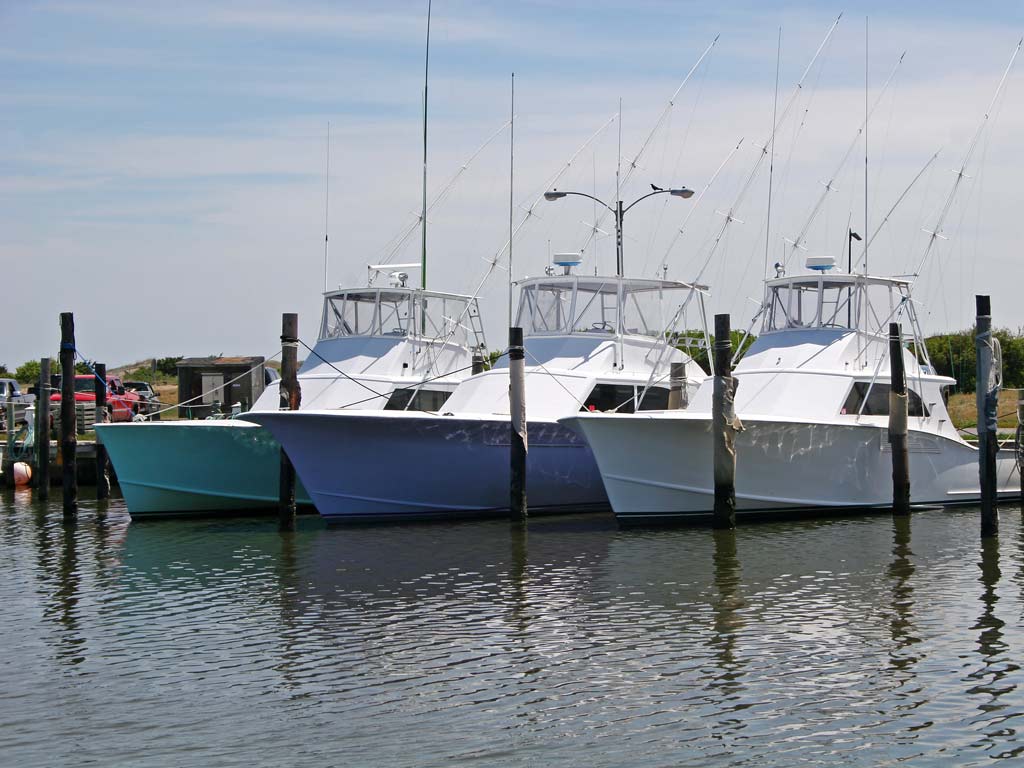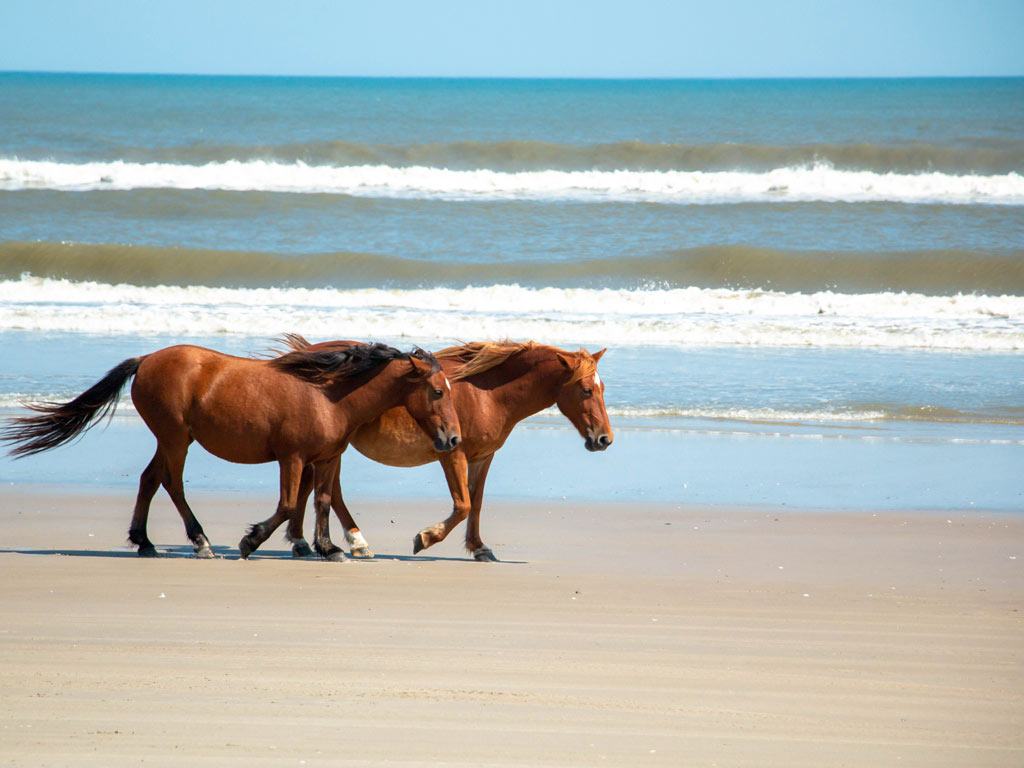With many bays, inlets, and sounds scattered along its Atlantic waterfront, the Tar Heel State features incredible angling even close to its shores. However, those who dare to take a crack at deep sea fishing in North Carolina will find that there’s so much more on offer. As long as you’re willing to brave the journey, you’re set to discover an offshore arena like very few others.

It’s all thanks to the Gulf Stream, a warm ocean current flowing around 30 miles off North Carolina’s coast. Its waters provide a traveling path for all kinds of pelagic species, including prizefighters such as Tuna and Billfish. If that’s not enough, you can always drop your line to the ocean floor where a range of tasty bottom dwellers awaits.
In this post, we’ll give an overview of the different fish you’ll face while deep sea fishing in North Carolina. We’ll also cover the best seasons to go for them, as well as the basic techniques you’ll make use of. Towards the end, we’ll mention a few starting spots and some regulations you should keep in mind.
Top Deep Sea Fishing Targets in North Carolina
It’s safe to say that the species you’ll encounter along this part of the East Coast amount to more than a few. After all, North Carolina boasts over 300 miles of coastline, and the Gulf Stream runs along the entire length of it. To give you an idea of what to expect, here are some of our favorite game species you can catch out here.
Marlin and Sailfish
In the world of sportfishing, there are few species more prestigious than the likes of Marlin and Sailfish. And it’s fairly obvious why! We’re talking about fish that can swim at speeds of over 70 mph, leap several feet into the air, and grow to incredible sizes.

Whether it’s a Marlin or a Sailfish you’re targeting, you’ll be in for a serious battle of willpower and endurance. In terms of difficulty, the smaller Sailfish are considered to be easier to catch. But this is simply because Marlin possess almost unmatched durability and athleticism. This being said, both fish are capable of giving any angler a run for their money.
Another thing that makes Sailfish frequent contenders in South Carolina is that they’re more abundant. Even though you can find both Blue and White Marlin along North Carolina’s portion of the Gulf Stream, they’re still rare and elusive. However, if you’re lucky enough for Marlin to grace you with their presence, it’ll be an angling memory to last you a lifetime.
Tuna
If there’s a species around these parts that can go toe to toe with Billfish, it’s definitely Bluefin Tuna. While these deep sea brutes may not be quite as fast or acrobatic as Marlin, they make up for it with sheer horsepower and raw tenacity. Bluefin can make runs that’ll make it seem like you’re trying to reel in an F-150, and they can do so for hours.

Of course, Bluefin are not the only Tuna species you’ll find while deep sea fishing in North Carolina. Most of the time, your main target on a Tuna trip will be Yellowfin, the Bluefin’s smaller but still incredibly tough cousin. As you troll for Yellowfin, you’ll often see Blackfin and Bigeye Tuna biting as well. All of these are a blast to catch and thoroughly delicious to eat.
Mahi Mahi
For anglers who are just getting into deep sea fishing, there’s hardly a better target than Mahi Mahi. First of all, they often come closer to shore than other offshore species. Secondly, they’re eager biters who put up an exciting but fairly moderate fight. Finally, whether you cook, grill, or poach your Mahi, they’ll make for a meal fit for kings.

In North Carolina, Mahi Mahi are present in the area from late spring all the way up to mid-fall. If you’re aiming to catch as many as possible, it’s best to target them during summer. You’ll sometimes hear other anglers use the terms bailer and gaffer when talking about these fish. Trophy-sized specimens are called gaffer Mahi, while the smaller ones are known as bailers.
Wahoo
In case Wahoo haven’t made it onto your offshore bucket list yet, it’s high time to add them on there. These fish are among the fastest in the ocean, only beaten by the likes of Marlin and Sailfish. They’re also terrific fighters who’ll make your reel scream with tension as they bolt off with your hook.

But there’s one more reason why Wahoo are so beloved, and it’s their delicious taste. Their meat is mild-flavored and will make for a great dinner option if you’re not a fan of the gamey taste some other fish have. So if you’re looking for an exhilarating battle with tasty consequences, don’t miss out on catching some Wahoo.
…And Others!
The fish we’ve named so far are what most deep sea anglers dream of catching. However, there are plenty of other species you’ll have the chance to scrap with. Cobia, King Mackerel, False Albacore, and Barracuda are just some of the fish that prowl North Carolina waters.

You can also try bottom fishing whenever you’ve had your share of hunting for pelagics. Fish such as Amberjack, Black Seabass, Tilefish, Snapper, and various types of Grouper all lurk at the bottom of the ocean, waiting for the bait to drop. If you have the skills and you’re feeling lucky, you can also try exploring the depths for Swordfish.
Recent North Carolina Catches
Fresh fishing reports from anglers
How to Go Deep Sea Fishing in North Carolina
As you prepare for an offshore trip, you’ll need to cover a few bases in terms of vessel and equipment. You’ll need a sturdy boat that can handle the open waters and specialized tackle to reel in the big boys. If you’re looking for a simple way to get all of that, just hop on one of the deep sea fishing charters in North Carolina.

Besides the boat and the gear, you’ll also get one additional benefit if you fish on a charter – an experienced captain who will ensure your trip is safe and put you on that prized catch. A professional guide will also teach you how to fight and bring in the big fish. But to give you a sneak peek of what a deep sea trip may look like, here are some ways you’ll entice fish into biting…
Trolling
As far as techniques go, trolling is relatively straightforward. If you’re fishing on a charter, the crew will set up the trolling spread and bait the hooks. At that point, the captain will start driving the boat as you wait for a rod to start bending. Depending on what you’re targeting, the spread, the bait, and the speed you’ll troll at will vary, but the gist of the technique will remain the same.

Thanks to this, trolling is suitable even for complete beginners. Of course, this doesn’t mean you should go fight a Marlin without any prior experience. Instead, you can sharpen your skills with species such as Mahi Mahi or King Mackerel, before moving to bigger fish. Besides these, trolling is the preferred technique when you want to reel in the likes of Tuna or Wahoo.
Bottom Fishing
Even though trolling is one of the most efficient deep sea fishing techniques, sometimes you’ll just have to switch things up if you want to come home with some fish. For days when the pelagic bite is slow, bottom fishing is a fantastic option. With this technique, you’ll have a shot at all kinds of deep-dwelling fish that usually make for great table fare.

The basics of bottom fishing are fairly simple. Your captain will find a suitable ledge, reef, or wreck, and you’ll drop your hook to the bottom. If you’re fishing at greater depths, you’ll typically use electric reels. This variation is called deep dropping and it’s used both for big bottom fish, and to lure in the mighty Swordfish. Although this may seem easy, you’d be wise to keep in mind that it’ll still take skill to reel in the fish you hook this way.
When to Come Deep Sea Fishing in North Carolina
North Carolina’s part of the Gulf Stream features a year-round rotating cast of pelagic superstars. This means that you’ll have something to chase after no matter when you visit. However, most of the charter fishing season takes place between spring and early winter, as some guides take a break from running trips between January and April.

This doesn’t mean you can’t fish during the colder months. In fact, winter deep sea fishing in North Carolina can be an absolute blast. From December to April, Bluefin Tuna are in the area, giving you the unique opportunity to wrestle with these famous predators. You’ll also find different types of bottom fish throughout the year.
In spring, you’ll see the likes of Yellowfin Tuna and Mahi Mahi showing up. By the time summer arrives, the waters turn into a Billfish battleground, with Blue and White Marlin, as well as Sailfish racing through the Gulf Stream. They’re joined by Wahoo that’ll typically stay in the area until late fall. Towards the end of the year, you’ll switch back to fishing for Tuna.
Where to Go Deep Sea Fishing in North Carolina
For deep sea fishing purposes, you can split North Carolina’s coast into three different stretches. Among them, the most famous one is the Outer Banks area. It extends from the state’s northern border all the way down to Ocracoke, covering about 200 miles of coastline.

Besides being a fantastic vacation spot, the Outer Banks also offer the quickest access to offshore waters. If you’re trying to cut down on your travel time, base your trip from Hatteras. Thanks to its unique position, you’ll be deep sea fishing in the Gulf Stream before you know it.
South of the OBX, you’ll find the Crystal Coast. Here, you’ll see plenty of captains offering deep sea fishing trips out of Morehead City, Atlantic Beach, Beaufort, and along Topsail Island. Finally, if you’re planning a trip to the southern part of North Carolina, places such as Wilmington, Carolina Beach, or Southport can all serve as good starting points.
Anything else?

Before any good angling adventure can begin, you’ll need to get up to speed with local regulations. Luckily, if you’re deep sea fishing in North Carolina, you’ll most likely be doing it from a charter boat. On charters, you won’t need to worry about getting your fishing license. The regulations allow the captain to cover you with his own permit.
It’s also advisable to read up on size and bag limits, because it’ll give you a better idea of what fish you can keep and how many. For example, any Billfish that you manage to reel in will typically be released. If you’d like to know more, there’s a complete rundown of fish regulations on the North Carolina Department of Environmental Quality website.
North Carolina: Where Deep Sea Fishing Legends Are Made

By now, you should have an idea of what kind of fish prowl the offshore depths of North Carolina. That means the only missing component for an adventure is you – an angler willing to square up against these fierce predators. Beware though, some of them are armed with swords while others are blessed with incredible strength. To match them, you’ll need some knowledge, muscles, and, of course, a trusty rod and reel.
Have you ever been deep sea fishing in North Carolina? What’s your favorite fish to chase after? Hit the comment button and let us know!


